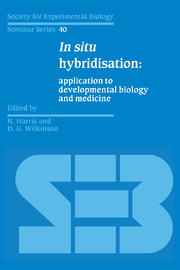Book contents
- Frontmatter
- Contents
- List of contributors
- Preface
- Non-radioisotopic labels for in situ hybridisation histochemistry: a histochemist's view.
- Use of haptenised nucleic acid probes in fluorescent in situ hybridisation
- The use of complementary RNA probes for the identification and localisation of peptide messenger RNA in the diffuse neuroendocrine system
- Contributions of the spatial analysis of gene expression to the study of sea urchin development
- Advantages and limitations of in situ hybridisation as exemplified by the molecular genetic analysis of Drosophila development
- The use of in situ hybridisation to study the localisation of maternal mRNAs during Xenopus oogenesis
- In situ hybridisation in the analysis of genes with potential roles in mouse embryogenesis
- Evolution of algal plastids from eukaryotic endosymbionts
- Localisation of expression of male flower-specific genes from maize by in situ hybridisation
- Tissue preparation techniques for in situ hybridisation studies of storage-protein gene expression during pea seed development
- Investigation of gene expression during plant gametogenesis by in situ hybridisation
- Sexing the human conceptus by in situ hybridisation
- Non-isotopic in situ hybridisation in human pathology
- The demonstration of viral DNA in human tissues by in situ DNA hybridisation
- Index
Advantages and limitations of in situ hybridisation as exemplified by the molecular genetic analysis of Drosophila development
Published online by Cambridge University Press: 04 August 2010
- Frontmatter
- Contents
- List of contributors
- Preface
- Non-radioisotopic labels for in situ hybridisation histochemistry: a histochemist's view.
- Use of haptenised nucleic acid probes in fluorescent in situ hybridisation
- The use of complementary RNA probes for the identification and localisation of peptide messenger RNA in the diffuse neuroendocrine system
- Contributions of the spatial analysis of gene expression to the study of sea urchin development
- Advantages and limitations of in situ hybridisation as exemplified by the molecular genetic analysis of Drosophila development
- The use of in situ hybridisation to study the localisation of maternal mRNAs during Xenopus oogenesis
- In situ hybridisation in the analysis of genes with potential roles in mouse embryogenesis
- Evolution of algal plastids from eukaryotic endosymbionts
- Localisation of expression of male flower-specific genes from maize by in situ hybridisation
- Tissue preparation techniques for in situ hybridisation studies of storage-protein gene expression during pea seed development
- Investigation of gene expression during plant gametogenesis by in situ hybridisation
- Sexing the human conceptus by in situ hybridisation
- Non-isotopic in situ hybridisation in human pathology
- The demonstration of viral DNA in human tissues by in situ DNA hybridisation
- Index
Summary
Introduction
Over the past five years the application of in situ hybridisation to the analysis of gene expression has made an immense contribution to the study of Drosophila development (for reviews, see Akam, 1987; Ingham, 1988). The advent of this technique not only allowed the verification of the inferences about normal gene expression based upon classical genetic analysis, but has also facilitated the investigation of regulatory interactions between genes. In addition, in a number of cases, in situ analysis has revealed novel roles for genes not previously predicted by mutational analysis.
In the first part of this paper we outline briefly the methodology and applications of the various in situ hybridisation protocols which have been used with this organism. In the second part, we review the recent advances in the analysis of Drosophila development and discuss the uses and limitations of the in situ technique in the study of genes of unknown biochemical function.
Methodology
Several protocols have been developed for the analysis of transcripts in situ (Hafen et at, 1983; Akam, 1983; Ingham, Howard & Ish-Horowicz, 1985; Mahoney & Lengyel, 1987), but probably the most convenient and widely applicable of these employs tissues which have been embedded and sectioned in paraffin wax.
A major advantage of wax-embedded material over frozen tissue is the ease with which it can be handled and sectioned; large amounts of material can be accumulated and stored at different stages of the procedure, either prior to or following embedding. In addition, wax sections can be cut on most microtomes, obviating the need for expensive (and cumbersome) cryostats, an important consideration where money and space are limiting.
- Type
- Chapter
- Information
- In Situ HybridisationApplication to Developmental Biology and Medicine, pp. 97 - 114Publisher: Cambridge University PressPrint publication year: 1990
- 2
- Cited by

